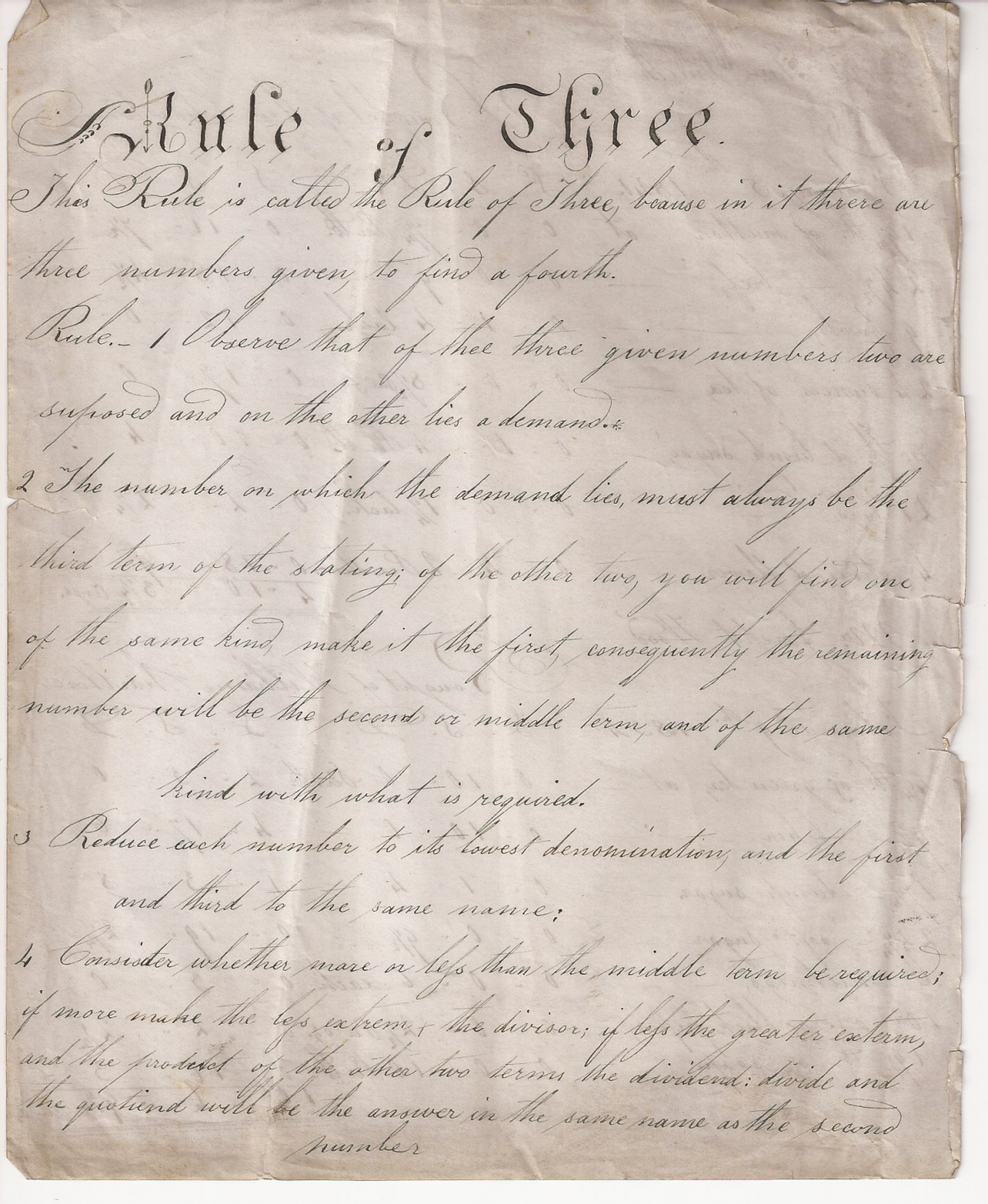Within the documents in the chest is a curious thing called ‘The Rule of Three’. I have looked it up, and it seems to some from ‘A new and complete system of arithmetick: composed for the use of the Citizens of the United States by Nicholas Pike and Nathaniel Lord. It is available to read at https://play.google.com/books/reader?id=fxNRAAAAYAAJ&printsec=frontcover&output=reader&hl=en_GB&pg=GBS.PP1 This version was published on the 1st January 1816. It starts with the words:
Be it remembered, that on the seventh day of November, in the thirty-fourth year of the Independence of the United States of America, Thomas and Andrews of the said district, have deposited in this office, the title of a book, the right whereof they claim as proprietors, in the words following, to wit: “A new and complete system of Arithmetic’.
According to the book:
The Rule of Three
If more require more, or less require less, the question belongs to the Rule of Three Direct.
But if more require less, or less require more, it belongs to the Rule of Three Inverse.
Rule of Three transcribed as it was written – spelling included!
Rule of Three
The Rule is called the Rule of Three, beause in it there are three numbers given, to find a fourth
Rule._1 Observer that of thee three given numbers two are suposed and on the other lies a demand.*
2 The number on which the demand lies, must always be the third term of the stating; of the other two, you will find one of the same kind, make it the first, consequently the remaining number will be the second or middle term, and of the same kind with what is required.
3 Reduce each number to its lowest denomination, and the first and third to the same name;
4 Consider whether more of less than the middle term be required; if more make the less extreme, the division; if less the greater exterm and the product of the other two terms the dividend: divide and the quotiend will be the answer in the same name as the second number.
On the reverse of ‘The Rule of Three’ is the costings for groceries ‘Bought of William Charlton’. What is odd about it is the first costing is from 1840 and the one underneath is from 1834. There is no date on the document to indicate when it was actually written. I wonder why he has a copy a book ‘for Citizens of the United States’? Maybe it was sent to him by his brother John. I also wonder if he understood what he was transcribing? It means nothing to me! He certainly seems to ave been an astute businessman, so must have had a head for figures.


I looked up what bohea was and according to Wikipedia – Wuyi tea, formerly known by the trade name “Bohea” in English, is a category of black and oolong teas grown in the Wuyi Mountains of northern Fujian, China.
I have transcribed both documents and it can be downloaded here Rule of Three transcription.



 Esther Elizabeth Charlton was born on the 19th November 1875 at Ebchester Hill, Durham. She was the daughter of Margaret (nee Hedley) and William Charlton. She had an elder brother called William Hedley Charlton (b. 21st June 1872, Broomhill Durham). But she was the second Esther Elizabeth Charlton of the family. Her father had been married previously, to an Elizabeth Braban. Together they had two daughters, Mary Ann (b. 1853 – d. 2.01.1860) and Esther Elizabeth (b. 25.04.1857 – d. 19.10.1858). Elizabeth (their mother) died tragically young in 1870. William Charlton married fairly soon after his wife’s death, on the 09 Mar 1871 at Benfieldside Parish Church, Durham.
Esther Elizabeth Charlton was born on the 19th November 1875 at Ebchester Hill, Durham. She was the daughter of Margaret (nee Hedley) and William Charlton. She had an elder brother called William Hedley Charlton (b. 21st June 1872, Broomhill Durham). But she was the second Esther Elizabeth Charlton of the family. Her father had been married previously, to an Elizabeth Braban. Together they had two daughters, Mary Ann (b. 1853 – d. 2.01.1860) and Esther Elizabeth (b. 25.04.1857 – d. 19.10.1858). Elizabeth (their mother) died tragically young in 1870. William Charlton married fairly soon after his wife’s death, on the 09 Mar 1871 at Benfieldside Parish Church, Durham.